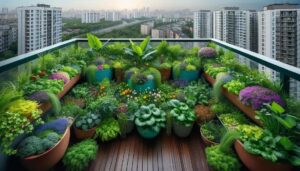Rooftop kale gardening optimally uses limited urban space, offering fresh produce by using breathable grow bags, strategic layouts, and season-specific care to manage pests and enhance growth, all contributing to a sustainable and nutritious home-grown harvest.
Kale in grow bags on your rooftop? You bet! This might sound unusual, but envision a garden space where every leaf counts. Rooftop gardening isn’t just for the urban dreamer anymore—it can be a reality, bringing you fresh produce right above your living space. Let’s explore how this works and why it could be perfect for you.
why grow kale on your rooftop
Growing kale on your rooftop can transform an underutilized area into a thriving green oasis. With urban spaces becoming increasingly limited, using rooftops for gardening is a smart solution. Kale, known for its nutritional powerhouse qualities, thrives in open-air environments where it receives plenty of sunlight. By leveraging your rooftop, you address space constraints and enjoy fresh, organic produce just steps away.
Rooftop gardening can also help regulate the temperature of your building, reducing energy costs by providing insulation. Moreover, it promotes better air quality and reduces urban heat effects. Imagine stepping outside and picking kale leaves for your salad every day. This not only adds convenience but also enhances your food’s freshness and flavor.
Health benefits are another critical reason to consider. Kale is rich in vitamins A, K, and C, and is a great source of calcium. Growing it right above your living quarters ensures you have access to these nutrients without the carbon footprint of transporting produce from farms to stores.
So next time you’re thinking about revamping your rooftop space, consider the sustainable and health-boosting option of growing kale.
choosing the right grow bags
When it comes to growing kale on your rooftop, selecting the right grow bags is crucial. These containers provide the flexibility and space necessary for your plants’ roots to expand. Start by choosing bags made of breathable materials like fabric. These allow for better aeration and drainage, preventing root rot and promoting healthy plant growth.
The size of the bags matters too. Opt for bags that are at least 5-7 gallons to ensure your kale has ample room to flourish. Larger bags can retain more soil moisture, reducing the frequency of watering, especially under sunlight.
Consider grow bags with reinforced handles. These make it easier to move the bags when needed, such as when repositioning them for optimal sunlight exposure as the seasons change. Additionally, ensure that the bags are UV resistant to withstand the outdoor conditions over time.
Overall, choosing the right grow bags can significantly impact your rooftop garden’s success, facilitating a bountiful harvest of fresh, nutritious kale.
planning your rooftop garden layout
Designing the layout of your rooftop garden is key to maximizing space and ensuring healthy plant growth. First, assess your rooftop’s conditions. Look out for areas with ample sunlight, as kale thrives in full sun. Arrange the grow bags in such a way that taller plants don’t overshadow smaller ones.
Create pathways for easy access. These paths not only make gardening more manageable but also prevent damage to plants from foot traffic. A well-planned layout includes a variety of container sizes. Place larger bags at the back and smaller ones at the front to ensure all plants receive sunlight.
Consider grouping plants with similar water needs together. This approach simplifies watering and helps prevent overwatering or underwatering issues. Think about utilizing vertical gardening techniques if space is limited. Vertical structures can be used for training vining plants, allowing more room on the ground for your kale and other crops.
Adding trellises or shelves can elevate some plants, making use of vertical space and adding depth to your garden’s design. Proper planning leads to efficient use of your rooftop, supporting a bountiful kale harvest and an aesthetically pleasing garden.
caring for kale through the seasons
Caring for kale as the seasons change requires attention to detail, ensuring a healthy harvest year-round. In warm months, kale thrives with full sun and needs regular watering, especially when temperatures soar. Ensure the soil remains moist but not waterlogged to prevent root issues.
As the weather cools, kale’s flavor improves, becoming sweeter with frost exposure. However, in colder seasons, protect your plants with fabric covers or cloches to keep frost damage at bay. Mulching around the base with straw or leaves can help insulate the roots and maintain soil temperature.
Keep an eye out for pests like aphids and cabbage worms throughout the year. Regular checks and applying natural pest control solutions, like neem oil, can safeguard your plants. Pruning yellow or damaged leaves also boosts overall plant health.
By adjusting care practices to fit each season, your rooftop kale can remain productive and delicious, supporting a continuous harvest cycle.
harvesting and enjoying fresh kale
When it’s time to harvest, focus on picking the outer leaves of your kale plant. This method encourages continuous growth and allows the plant to keep producing leaves. Use clean scissors to cut these leaves, ensuring a smooth cut that doesn’t harm the plant.
Freshly harvested kale is not only nutritious but also versatile in the kitchen. Try adding it to smoothies for a healthy boost or sauté it with garlic for a quick and tasty side dish. The leaves are tender when young and can also be used raw in salads.
Store your harvested kale in a cool refrigerator. Wrap it in a damp paper towel and place inside a plastic bag to maintain freshness for up to a week. You can also blanch and freeze the leaves for longer storage, ensuring you have kale whenever needed.
Enjoy your rooftop-grown kale as part of a balanced diet, appreciating both the flavors and the satisfaction of eating something you’ve grown yourself.
overcoming common growing challenges
Growing kale on your rooftop can be rewarding, but challenges do arise. One common issue is dealing with pests like aphids or caterpillars. To combat these, introduce natural predators such as ladybugs or use organic sprays to keep your plants pest-free.
Another challenge is managing soil quality. Use high-quality potting soil enriched with compost to provide the necessary nutrients. Regularly check the soil pH, ensuring it stays between 6.0 and 7.5 for optimal kale growth.
Weather conditions can also be a concern. Protect your plants from extreme heat by providing shade during the hottest parts of the day. In cooler seasons, use row covers to shield your kale from frost.
Watering can be tricky, too. Overwatering leads to root rot, while underwatering causes wilting. Aim to keep the soil consistently moist, allowing the top inch to dry between waterings.
With these strategies, you can tackle common growing obstacles and maintain a healthy, productive garden.
The Benefits of Rooftop Kale Gardening
Embarking on a journey of rooftop kale gardening brings numerous advantages. From maximizing limited urban space to enjoying fresh and nutritious produce, the benefits are vast.
By choosing the right grow bags, planning your layout carefully, and adjusting care throughout the seasons, you can overcome common challenges and savor a bountiful harvest.
Remember, with consistent care and a bit of creativity, your rooftop can transform into a thriving green haven that adds to your health and well-being.
Whether you’re a seasoned gardener or just starting, rooftop kale gardening is a rewarding experience.
FAQ – Common Questions about Rooftop Kale Gardening
Why should I grow kale on my rooftop?
Growing kale on your rooftop maximizes your available space and provides access to fresh, organic produce.
What type of grow bags are best for kale?
Choose fabric grow bags that are 5-7 gallons in size for proper aeration and root expansion.
How should I arrange my rooftop garden layout?
Arrange grow bags to maximize sunlight, and create pathways for easy access while considering plant heights to prevent shading.
What are common pests that affect kale and how do I manage them?
Aphids and caterpillars are common pests. Managing them with natural predators or organic sprays is effective.
How do I care for kale through different seasons?
Water regularly in summer and protect from frost in winter with fabric covers while adjusting care to suit seasonal changes.
When is the best time to harvest kale?
Harvest kale by cutting the outer leaves when they are mature, ensuring continuous growth of inner leaves.



